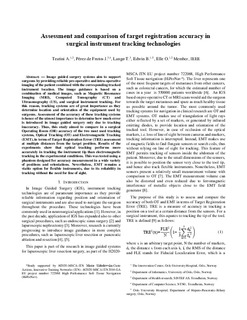Assessment and comparison of target registration accuracy in surgical instrument tracking technologies
Journal article, Peer reviewed
Accepted version

Åpne
Permanent lenke
http://hdl.handle.net/11250/2593612Utgivelsesdato
2018Metadata
Vis full innførselSamlinger
Originalversjon
IEEE Engineering in Medicine and Biology Society. Conference Proceedings. 2018, 40th 1845-1848. 10.1109/EMBC.2018.8512671Sammendrag
Image guided surgery systems aim to support surgeons by providing reliable pre-operative and intra-operative imaging of the patient combined with the corresponding tracked instrument location. The image guidance is based on a combination of medical images, such as Magnetic Resonance Imaging (MRI), Computed Tomography (CT) and Ultrasonography (US), and surgical instrument tracking. For this reason, tracking systems are of great importance as they determine location and orientation of the equipment used by surgeons. Assessment of the accuracy of these tracking systems is hence of the utmost importance to determine how much error is introduced in image guided surgery only due to tracking inaccuracy. Thus, this study aimed to compare in a surgical Operating Room (OR) accuracy of the two most used tracking systems, Optical Tracking (OT) and Electromagnetic Tracking (EMT), in terms of Target Registration Error (TRE) assessment at multiple distances from the target position. Results of the experiments show that optical tracking performs more accurately in tracking the instrument tip than electromagnetic tracking in the experimental conditions. This was tested using a phantom designed for accuracy measurement in a wide variety of positions and orientations. Nevertheless, EMT remains a viable option for flexible instruments, due to its reliability in tracking without the need for line of sight.